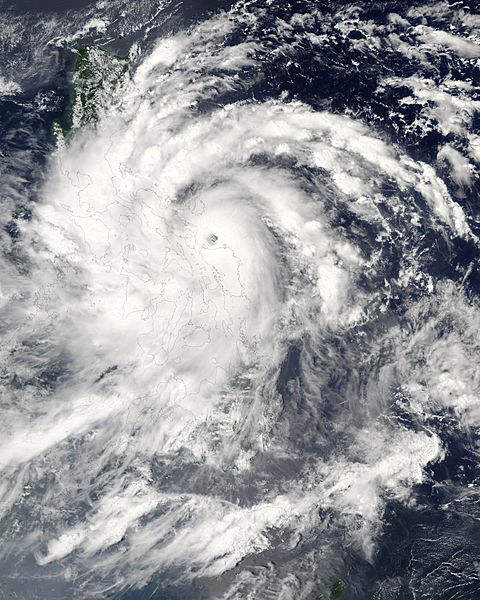Image: Typhoon Xangsane 27 sept 2006

Description: Typhoon Xangsane formed on September 25, 2006, in the western Pacific near the coast of the Philippine Islands. Over the next 36 hours, it grew from a tropical depression (area of low air pressure) to a typhoon. As of September 27, it was right on the eastern edge of the Philippines, with the eye of the storm sitting just offshore. Winds had reached 210 kilometers per hour (130 miles per hour) near the core of the storm, according to the University of Hawaii’s Tropical Storm Information Center. This photo-like image was acquired by the Moderate Resolution Imaging Spectroradiometer (MODIS) on the Terra satellite on September 27, 2006, at 1:00 p.m. local time (05:00 UTC). Xangsane at the time of this image was a well-defined, spiraling swirl of clouds, with a distinct, but cloud-filled (“closed”) eye. The arm structure was not tightly wound, a trait of a moderately young storm. According to news reports, the Philippine Coast Guard had suspended ferry traffic at ports across the region due to strong winds and high waves, leaving thousands of passengers temporarily stranded. Heavy rains triggered flash flooding that had trapped perhaps 100 families in their homes in the central Philippines. Storm track projections on September 27 suggested that the typhoon would lose power as it crossed the islands and rebuild only slightly as it continued west across the South China Sea. The storm was predicted to come ashore on the Asian mainland in central Vietnam on or around October 2. The high-resolution image provided above is at MODIS’ full spatial resolution (level of detail) of 250 meters per pixel. The MODIS Rapid Response System provides this image at additional resolutions.
Title: Typhoon Xangsane 27 sept 2006
Credit: http://earthobservatory.nasa.gov/NaturalHazards/natural_hazards_v2.php3?img_id=13896
Author: NASA image by Jeff Schmaltz, MODIS Rapid Response Team, Goddard Space Flight Center.
Permission: This file is in the public domain in the United States because it was solely created by NASA. NASA copyright policy states that "NASA material is not protected by copyright unless noted". (See Template:PD-USGov, NASA copyright policy page or JPL Image Use Policy.) Warnings: Use of NASA logos, insignia and emblems is restricted per U.S. law 14 CFR 1221. The NASA website hosts a large number of images from the Soviet/Russian space agency, and other non-American space agencies. These are not necessarily in the public domain. Materials based on Hubble Space Telescope data may be copyrighted if they are not explicitly produced by the STScI.[1] See also Template:PD-Hubble and Template:Cc-Hubble. The SOHO (ESA & NASA) joint project implies that all materials created by its probe are copyrighted and require permission for commercial non-educational use. [2] Images featured on the Astronomy Picture of the Day (APOD) web site may be copyrighted. [3] The National Space Science Data Center (NSSDC) site has been known to host copyrighted content even though its photo gallery FAQ states that all of the images in the photo gallery are in the public domain.
Usage Terms: Public domain
License: Public domain
Attribution Required?: No
Image usage
The following page links to this image:

